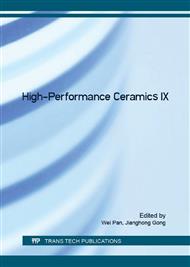[1]
C. Kral, W. Lengauer, D. Rafaja, and P. Ettmayer, Critical Review on the lastic Properties of Transition Metal Carbides, Nitrides and Carbonitrides, J. Alloys Compd. 265 (1998) 215-33.
DOI: 10.1016/s0925-8388(97)00297-1
Google Scholar
[2]
R. Chang and I. J. Graham, Low-Temperature Elastic Properties of ZrC and TiC, J. Appl. Phys. 37 (1966) 3778-83.
Google Scholar
[3]
M. H. Leipold and T. H. Nielsen, Mechanical Properties of Hot-Pressed Zironium Carbide Tested to 26001C, J. Am. Ceram. Soc. 47 (1964) 419-24.
Google Scholar
[4]
L.F. He, Z.J. Lin, J.Y. Wang, Y.W. Bao, M.H. Li, Y.C. Zhou, Synthesis and Characterization of Bulk Zr2Al3C4 Ceramic, J. Am. Ceram. Soc. 90 (2007) 3687-89.
Google Scholar
[5]
L.F. He, Y.C. Zhou, Y.W. Bao, Z.J. Lin, J.Y. Wang, Physical, and Mechanical Properties of Bulk Zr3Al3C5 Ceramic, J. Am. Ceram. Soc. 90 (2007) 1164-70.
Google Scholar
[6]
R.B. Zhang, G.Q. Chen, W.B. Han, Synthesis, mechanical and physical properties of bulk Zr2Al4C5 ceramic, Mater. Chem. Phys. 119 (2010) 261-65.
Google Scholar
[7]
K. Sugiura, T. Iwata, H. Yoshida, S. Hashimoto, K. Fukuda, Syntheses, crystal structures and Si solubilities of new layered carbides Zr2Al4C5 and Zr3Al4C6, J. Solid. State. Chem. 181 (2008) 2864-68.
DOI: 10.1016/j.jssc.2008.07.017
Google Scholar
[8]
L.F. He, X.P. Lu, Y.W. Bao, J.Y. Wang, Y.C. Zhou, High-temperature internal friction, stiffness and strength of Zr-Al(Si)-C ceramics, Scr. Mater. 61 (2009) 60-63.
DOI: 10.1016/j.scriptamat.2009.03.004
Google Scholar
[9]
Z.J. Lin, L.F. He, J.Y. Wang, M.S. Li, Y.W. Bao, Y.C. Zhou, Atomic-scale microstructure and elastic properties of quaternary Zr-Al-Si-C ceramics, Acta Mater. 56 (2008) 2022-31.
DOI: 10.1016/j.actamat.2007.12.055
Google Scholar
[10]
L. F. He, Y. W. Bao, M. S. Li, J. Y. Wang, and Y. C. Zhou, Oxidation of Zr2[Al(Si)]4C5 and Zr3[Al(Si)]4C6, J. Mater. Res. 23 (2008) 3339-46.
DOI: 10.1111/j.1551-2916.2010.03718.x
Google Scholar
[11]
J. Xu, and Y. Akishige, Relaxor in KF-doped BaTi2O5 ceramic by spark plasma sintering, Appl. Phys. Lett. 92 (2008) 052902.
DOI: 10.1063/1.2841712
Google Scholar
[12]
S. Luo, C. Wang, X. Zhou, Q. Shen, and L. Zhang, Fabrication and characterizations of Zn1-xCoxO bulk ceramics prepared by solid state reaction combined with spark plasma sintering, J. Mater. Sci. Mater. El. 23 (2012) 1477-84.
DOI: 10.1007/s10854-011-0614-4
Google Scholar
[13]
X. Tang, W. Xie, H. Li, W. Zhao, Q. Zhang, and M. Niino, Preparation and thermoelectric transport properties of high-performance p-type Bi2Te3 with layered nanostructure, Appl. Phys. Lett. 90 (2007) 012102.
DOI: 10.1063/1.2425007
Google Scholar
[14]
Q. Guo, and S. Luo, Improved thermoelectric efficiency in p-type ZnSb through Zn deficiency. Funct. Mater. Lett. 8 (2015) 1550028.
DOI: 10.1142/s1793604715500289
Google Scholar
[15]
Q. Guo, Y. Yang, J. Li, Q. Shen, and L. Zhang, In situ synthesis and properties of Zr2Al3C4/ZrB2 composites, Mater. Des. 32 (2011) 4289-94.
Google Scholar
[16]
Q. Guo, J. Li, Q. Shen, and L. Zhang, Preparation and characterization of ZrB2-SiC-Zr2Al4C5 composites by spark plasma sintering-reactive synthesis (SPS-RS) method, Mater. Sci. Eng. A 558 (2012) 186-92.
DOI: 10.1016/j.msea.2012.07.109
Google Scholar
[17]
Q. Guo, S. Luo, J. Gan, J. Li, and L. Zhang, Effect of ball milled Zr/Al/ZrB2 composite powders on microstructure and toughening of ZrB2/SiC/Zr-Al-C composite ceramics by spark plasma sintering, Mater. Sci. Eng. A 644 (2015) 96-104.
DOI: 10.1016/j.msea.2015.07.010
Google Scholar
[18]
X.F. Zhang, Q. Yang, and L.C. De Jonghe, Microstructure Development in Hot-Pressed Silicon Carbide: Effects of Aluminum, Boron, and Carbon Additives, Acta Mater. 51 (2003) 3849-60.
DOI: 10.1016/s1359-6454(03)00209-x
Google Scholar
[19]
K. Sugiura, T. Iwata, H. Yoshida, S. Hashimoto, K. Fukuda, Syntheses, crystal structures and Si solubilities of new layered carbides Zr2Al4C5 and Zr3Al4C6, J. Solid. State. Chem. 181 (2008) 2864-68.
DOI: 10.1016/j.jssc.2008.07.017
Google Scholar
[20]
L.F. He, Y.W. Bao, J.Y. Wang, M.S. Li, Y.C. Zhou, Mechanical and thermophysical properties of Zr–Al–Si–C ceramics, J. Am. Ceram. Soc. 92 (2009) 445-51.
DOI: 10.1111/j.1551-2916.2008.02879.x
Google Scholar


